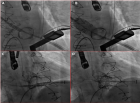Abstract
Case Report
Single Trans apical access for double aortic and mitral valves-in-valves procedures with high risk of thrombus embolism
Julien Adjedj*, Mathias Kirsch, Anna Nowacka and Olivier Muller
Published: 16 July, 2019 | Volume 4 - Issue 2 | Pages: 071-072
Background: Persistent left atrial thrombus remains a contra indication to transeptal valves in valves procedure. We aimed to perform a double valves in valves replacement through transapical access with cerebral angiography control during the procedure just after implantation. Our case shows the feasibility of this strategy and the management of right ventricle laceration successfully treated after extra corporeal membrane oxygenation implantation and local hemostasis. We reported a feasibility case report of successful double valves in valves implantation through transapical access with 6 months of clinical and computed tomography follow up.
Read Full Article HTML DOI: 10.29328/journal.jccm.1001042 Cite this Article Read Full Article PDF
Keywords:
Valves in valves; Apical access; Right ventricle laceration
References
- Ando T, Takagi H, Briasoulis A, Telila T, Slovut DP, et al. A systematic review of reported cases of combined transcatheter aortic and mitral valve interventions. Catheter Cardiovasc Interv. 2018; 91: 124-34. PubMed: https://www.ncbi.nlm.nih.gov/pubmed/28862381
- Eggebrecht H, Schmermund A, Voigtländer T, Kahlert P, Erbel R, et al. Risk of stroke after transcatheter aortic valve implantation (tavi): A meta-analysis of 10,037 published patients. EuroIntervention. 2012; 8: 129-38. PubMed: https://www.ncbi.nlm.nih.gov/pubmed/22391581
- Gülker JE, Schott P, Katoh M, Bufe A. Case report: Cerebral stentretreiver thrombectomy of an embolized valve fragment after valve in valve tavi. Clin Res Cardiol 2016; 105: 372-5. PubMed: https://www.ncbi.nlm.nih.gov/pubmed/26514354
Figures:

Figure 1

Figure 2
Similar Articles
-
Single Trans apical access for double aortic and mitral valves-in-valves procedures with high risk of thrombus embolismJulien Adjedj*,Mathias Kirsch,Anna Nowacka ,Olivier Muller. Single Trans apical access for double aortic and mitral valves-in-valves procedures with high risk of thrombus embolism. . 2019 doi: 10.29328/journal.jccm.1001042; 4: 071-072
Recently Viewed
-
Intersecting Pathways: Examining Hildegard Peplau's and Rosemarie Parse's Nursing Theories through a Comparative LensMehtab Lalwani*, Rafat Jan and Salma Rattani. Intersecting Pathways: Examining Hildegard Peplau's and Rosemarie Parse's Nursing Theories through a Comparative Lens. Clin J Nurs Care Pract. 2023: doi: 10.29328/journal.cjncp.1001046; 7: 009-014
-
Sinonasal Myxoma Extending into the Orbit in a 4-Year Old: A Case PresentationJulian A Purrinos*, Ramzi Younis. Sinonasal Myxoma Extending into the Orbit in a 4-Year Old: A Case Presentation. Arch Case Rep. 2024: doi: 10.29328/journal.acr.1001099; 8: 075-077
-
Spontaneously Reduced Focal Atrial Tachycardia after Cannabis OverdoseBoudar Aicha*,Cheikh Bay Ahmed,Haboub Mariem,Habbal Rachida. Spontaneously Reduced Focal Atrial Tachycardia after Cannabis Overdose. J Cardiol Cardiovasc Med. 2025: doi: 10.29328/journal.jccm.1001202; 10: 001-004
-
Effect of Methyl Jasmonate on the Expression of Transcription Factors in Wild Jujube Seedlings under Salt StressJianing Chen, Guangping Wang, Hanyun Liang, Yan Zhao, Xin Gao, Xiankuan Li*, Jian Zhang*. Effect of Methyl Jasmonate on the Expression of Transcription Factors in Wild Jujube Seedlings under Salt Stress. Arch Biotechnol Biomed. 2024: doi: 10.29328/journal.abb.1001038; 8: 003-008
-
Correlation of plasma protein from MDS, young and elderly patients by SDS-pageNathanielly de Lima Silva*,Josiel Nascimento dos Santos,Márcia Santos Rezende,Lúcio Henrique Sousa Pinheiro,Carlos Arthur Cardoso Almeida,Dulce Marta Schimieguel,Danilo Nobre. Correlation of plasma protein from MDS, young and elderly patients by SDS-page. Int J Bone Marrow Res. 2019: doi: 10.29328/journal.ijbmr.1001009; 2: 087-088
Most Viewed
-
Evaluation of Biostimulants Based on Recovered Protein Hydrolysates from Animal By-products as Plant Growth EnhancersH Pérez-Aguilar*, M Lacruz-Asaro, F Arán-Ais. Evaluation of Biostimulants Based on Recovered Protein Hydrolysates from Animal By-products as Plant Growth Enhancers. J Plant Sci Phytopathol. 2023 doi: 10.29328/journal.jpsp.1001104; 7: 042-047
-
Sinonasal Myxoma Extending into the Orbit in a 4-Year Old: A Case PresentationJulian A Purrinos*, Ramzi Younis. Sinonasal Myxoma Extending into the Orbit in a 4-Year Old: A Case Presentation. Arch Case Rep. 2024 doi: 10.29328/journal.acr.1001099; 8: 075-077
-
Feasibility study of magnetic sensing for detecting single-neuron action potentialsDenis Tonini,Kai Wu,Renata Saha,Jian-Ping Wang*. Feasibility study of magnetic sensing for detecting single-neuron action potentials. Ann Biomed Sci Eng. 2022 doi: 10.29328/journal.abse.1001018; 6: 019-029
-
Pediatric Dysgerminoma: Unveiling a Rare Ovarian TumorFaten Limaiem*, Khalil Saffar, Ahmed Halouani. Pediatric Dysgerminoma: Unveiling a Rare Ovarian Tumor. Arch Case Rep. 2024 doi: 10.29328/journal.acr.1001087; 8: 010-013
-
Physical activity can change the physiological and psychological circumstances during COVID-19 pandemic: A narrative reviewKhashayar Maroufi*. Physical activity can change the physiological and psychological circumstances during COVID-19 pandemic: A narrative review. J Sports Med Ther. 2021 doi: 10.29328/journal.jsmt.1001051; 6: 001-007

HSPI: We're glad you're here. Please click "create a new Query" if you are a new visitor to our website and need further information from us.
If you are already a member of our network and need to keep track of any developments regarding a question you have already submitted, click "take me to my Query."






















































































































































